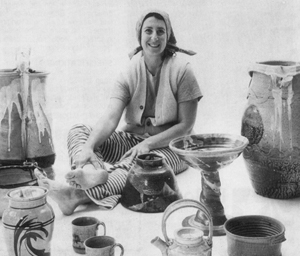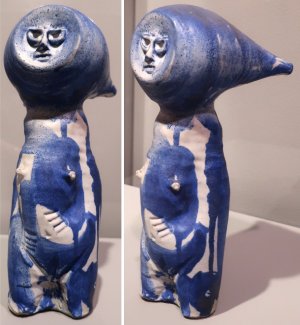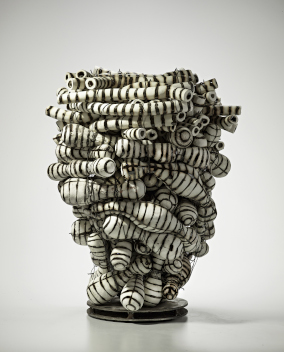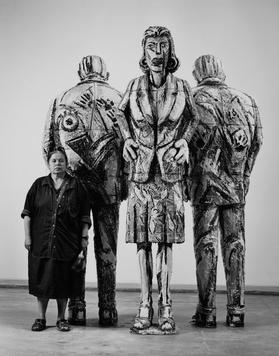Paul Edmund Soldner was an American ceramic artist and educator, noted for his experimentation with the 16th-century Japanese technique called raku, introducing new methods of firing and post firing, which became known as American Raku. He was the founder of the Anderson Ranch Arts Center in 1966.

Peter Voulkos was an American artist of Greek descent. He is known for his abstract expressionist ceramic sculptures, which crossed the traditional divide between ceramic crafts and fine art. He established the ceramics department at the Los Angeles County Art Institute and at UC Berkeley.

The Renwick Gallery is a branch of the Smithsonian American Art Museum located in Washington, D.C. that displays American craft and decorative arts from the 19th to 21st century. The gallery is housed in a National Historic Landmark building that was opened in 1859 on Pennsylvania Avenue and originally housed the Corcoran Gallery of Art. When it was built in 1859, it was called "the American Louvre", and is now named for its architect James Renwick Jr.
D. Wayne Higby is an American artist working in ceramics. The American Craft Museum considers him a "visionary of the American Crafts Movement" and recognized him as one of seven artists who are "genuine living legends representing the best of American artists in their chosen medium."

Elizabeth Woodman was an American ceramic artist.
Adrian Saxe is an American ceramic artist who was born in Glendale, California in 1943. He lives and works in Los Angeles, California.

Arnold Zimmerman (1954-2021), also known as Arnie Zimmerman, was an American sculptor and ceramic artist. His work ranged from monumental to miniature, and abstract to figurative, encompassing totemic vessel forms, tabletop sculpture and figures, murals, and room-size installations. He was part of a multi-decade, 20th-century shift in American ceramics during which artists challenged clay's identification with function and craft, engaging fine-art domains such as emotional expression, social commentary, figuration and narrative. Zimmerman first gained recognition in the 1980s for deeply carved, architectonic sculptures characterized by rough physicality, rhythmic surfaces, gestural presence and Italian Romanesque influences. In the mid-1990s, he shifted to figurative work that critic Donald Kuspit wrote, examined the interaction of finite man and infinite matter, artist and creative work: "There is a sense of futility and folly as well as seemingly senseless idealism and innocence built into Zimmerman's parables of the all-too-human."

Claude Horan was an American ceramic and glass artist who was born in Long Beach, California. He received a BA from San Jose State University in 1942 and an MA degree in art from Ohio State University in 1946. His wife Suzi Pleyte Horan collaborated on many of the larger projects. He was a lifeguard and longboard surfer in Santa Cruz in the late 1930s, and is credited with naming Steamer Lane.

Sergei Isupov is a ceramic artist born in Stavropol, Russia, now living in Cummington, Massachusetts, United States, and Tallinn, Estonia. He was educated at the Ukrainian State Art School in Kiev and went on to graduate in 1990 from the Art Institute of Tallinn in Estonia with Bachelor of Arts and Master of Fine Arts degrees in ceramic art. He has since exhibited widely in both solo and group exhibitions, received numerous awards, and widely collected by museums and private collectors.

Annabeth Rosen is an American sculptor best known for abstract ceramic works, as well as drawings. She is considered part of a second generation of Bay Area ceramic artists after the California Clay Movement, who have challenged ceramic traditions involving expression, form and function and helped spur the medium's acceptance in mainstream contemporary sculpture. Rosen's sculptures range from monumental to tabletop-sized, and emerge out of an accumulative bricolage process combining dozens or hundreds of fabricated parts and clay fragments and discards. Reviewers characterize her art as deliberately raw, both muscular and unapologetic feminine, and highly abstract yet widely referential in its suggestions of humanoid, botanical, aquatic, artificial, even science-fictional qualities. Critic Kay Whitney wrote that her work is "visceral in its impact, violent even, but also sensual and evocative" and "floats between the poles of the comic and the mordant."

Rupert Deese was an American ceramic artist. He is known for innovative design and decoration of high fired ceramics. Deese wrote "It is my hope in making these vessels that as the perception of their beauty diminishes over time, they will sustain themselves by pleasant usefulness."

Viola Frey was an American artist working in sculpture, painting and drawing, and professor emerita at California College of the Arts. She lived and worked in the San Francisco Bay Area and was renowned for her larger-than-life, colorfully glazed clay sculptures of men and women, which expanded the traditional boundaries of ceramic sculpture.
Patti Warashina is an American artist known for her imaginative ceramic sculptures. Often constructing her sculptures using porcelain, Warashina creates narrative and figurative art. Her works are in the collection of the Museum of Arts and Design, New York, National Museum of Modern Art, Kyoto, and the Smithsonian American Art Museum.

Harvey Goldman is an American artist and educator.

Harrison Edward McIntosh was an American ceramic artist. He was an exponent of the Mid-century Modern style of ceramics, featuring simple symmetrical forms. His work has been exhibited in venues in the United States including the Smithsonian and internationally including at the Louvre in France.
Kurt Weiser is an American ceramicist and professor. His work—explorations of the relationship between man and nature through narratives rendered in vivid color—are described as "Eden-like." His work has often taken the form of teapots, vases, and cups, though he has recently begun crafting globes as well. Weiser is currently the Regents Professor at Arizona State University's School of Art.
Carlos Alfonzo (1950–1991) was a Cuban-American painter known for his neo-impressionistic style. His work has been collected by Whitney Museum of American Art and Smithsonian Institution.

John Parker Glick was an American ceramicist. Though open to artistic experimentation, Glick was most influenced by the styles and aesthetics of Asian pottery—an inspiration that shows in his use of decorative patterns and glaze choices. His experience working with ceramics led him to publish several articles about the craft. In addition to producing pottery, Glick began making "landscape oriented" wall panels during the latter part of his career. Known as "the people's potter," he is primarily remembered for his contributions to art and the field of ceramics.
Chris Gustin is an American ceramicist. Gustin models his work on the human form, which is shown through the shape, color, and size of the pieces.
Tip Toland is an American ceramic artist and teacher who was born in Pottstown, Pennsylvania. She earned a BFA in Ceramics from the University of Colorado and an MFA in Ceramics from Montana State University. Her works, which are figurative and often described as "hyper-real," are held by galleries and museums around the United States.











